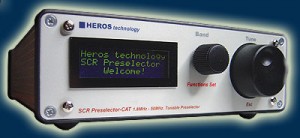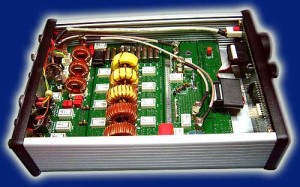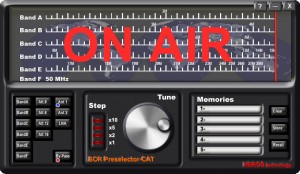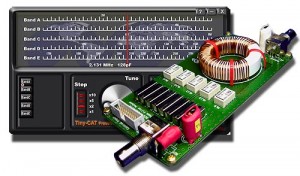 I stumbled upon this little toy last year when I installed the latest version of PowerSDR and saw that a menu called “Heros” had suddenly appeared. I started to do some digging and was eventually led to the Heros Technology website where I was introduced to the Heros SCR-Preselector.
I stumbled upon this little toy last year when I installed the latest version of PowerSDR and saw that a menu called “Heros” had suddenly appeared. I started to do some digging and was eventually led to the Heros Technology website where I was introduced to the Heros SCR-Preselector.
The idea of a preselector isn’t a new one: it’s a device that sits in between the antenna and the receiver (before all of the IF stages) and removes unwanted emissions and harmonics from the energy received by the antenna before passing that energy on to the receiver. It isn’t as big of a deal in North America as it used to be, but in Europe, where big-power shortwave radio stations still operate, they’re a little more widely used.
 I’d never thought I needed one of these little guys before. However, I run a Flex 5000A SDR (software defined radio), and I’ve learned that, in order to make these radios as broadbanded as possible, the receiver’s front end is REALLY open and lets in a lot more RF energy that it needs to. For example, I live about 10km straight-line from CBC’s 740KHz AM transmitter. I can hear a perfect image of this radio station on 5405KHz (Channel 5 on 60m) on my Flex at S9+5dB. This means that the energy from 740AM is getting into my radio, and the receiver is confusing that energy and passing that energy onto the next stages (IF, RF amp, etc..). However, once I put the Heros Preselector into the RF chain, poof, the image is gone. In fact, when I tune down to the medium wave “AM Broadcast” band, I can’t hear a thing; it kills them all.
I’d never thought I needed one of these little guys before. However, I run a Flex 5000A SDR (software defined radio), and I’ve learned that, in order to make these radios as broadbanded as possible, the receiver’s front end is REALLY open and lets in a lot more RF energy that it needs to. For example, I live about 10km straight-line from CBC’s 740KHz AM transmitter. I can hear a perfect image of this radio station on 5405KHz (Channel 5 on 60m) on my Flex at S9+5dB. This means that the energy from 740AM is getting into my radio, and the receiver is confusing that energy and passing that energy onto the next stages (IF, RF amp, etc..). However, once I put the Heros Preselector into the RF chain, poof, the image is gone. In fact, when I tune down to the medium wave “AM Broadcast” band, I can’t hear a thing; it kills them all.
Now, there have been preselectors for sale for a long time, but the catchy thing about this one is that it will track your dial using the CAT (Computer Aided Tuning) protocol. And the “skirt” is so tight that tuning frequency even by a few KHz will cause the preselector to change position. So whenever I change bands or spin the dial, the Heros Preselector moves with me. The model I have has a USB interface that acts as a serial port once interfaced to your computer. You can either use the software that Heros packages with the unit, or you can point the unit to your Flex, or any other CAT-supported radio. If you don’t want to use the tracking features, you can use the front panel controls to manually tune the unit.
(Updated 2019-03-23) Those are all the “pros.” The only real con is the USB interface, and they have made great strides to fix the issues they had with the earlier models. I sent my unit back to have v2020 of the firmware installed and since its return, I haven’t had any significant issues with the USB to Serial CAT interface, and the drivers that are used are now signed 64-bit drivers that don’t require you to put your PC into a driver test mode. I use the device with DDUtil by K5FR and it tracks with my Flex 5000a perfectly.

When I turn the preselector on at night when I’m on 80m or 40m, the noise goes down 2 S-units. On 160m, sometimes the noise goes down as much as 3.5 S-Units! I live in a small town, but the power lines run right behind my house, and all the way up the fence to my house, right beside and at some points parallel to my wire antennas. To have an S5 noise level on 80m at night in this environment is a dream come true. I’ve pondered buying another one and seeing how it does when operating HF mobile 🙂
 Nige Coleman, G7CNF, has made a great YouTube demonstration video of the Heros Preselector for anyone interested in seeing this unit in operation. The device costs £586.00 (that’s British Pounds). They also make a smaller, less expensive unit, the Tiny SCR-Preselector, which costs between £55.00 and £235.00 depending on the options you want (these prices are excluding European VAT).
Nige Coleman, G7CNF, has made a great YouTube demonstration video of the Heros Preselector for anyone interested in seeing this unit in operation. The device costs £586.00 (that’s British Pounds). They also make a smaller, less expensive unit, the Tiny SCR-Preselector, which costs between £55.00 and £235.00 depending on the options you want (these prices are excluding European VAT).
If you live in a high-noise area, or are operating a receiver with a very loose front-end, then I would recommend to your most serious contemplation the acquisition of one of these fine products.
vy 73 de VA3QR.
